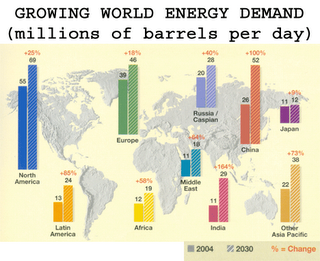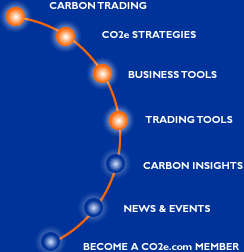CARBON CAPS ARE COMING
Power execs see carbon emission caps
Brad Foss, October 21, 2006 (Associated Press via MercuryNews.com)

- When Duke Energy Corp. CEO James E. Rogers considers global warming, he sees more than a costly quagmire for the U.S. power industry; he sees grand monuments. Notre Dame in Paris, St. Peter's Basilica in Rome…Rogers has adopted what he calls "cathedral thinking," a view that tackling climate change is a chance for the industry to leave a proud environmental legacy for future generations.
- This philosophy may not deliver results as quickly as environmentalists would like, or sit well with all his counterparts, but it does aptly describe an approach toward reducing greenhouse gases that a small but growing number of power executives are embracing…Rogers and many other executives are convinced the United States is likely to join Europe in placing limits on carbon dioxide emissions - believed by scientists to cause global warming - perhaps as early as next decade. This rising expectation of mandatory carbon caps is reviving interest in nuclear power, accelerating the use cleaner coal-burning technologies and spurring investment in alternative fuels such as wind and biomass.
- Some of the country's biggest power producers are even setting voluntary greenhouse-gas reduction goals now in hopes of gaining a competitive edge down the road…
- Despite good intentions, however, it will likely be several decades before any meaningful progress is made on reducing carbon emissions, according to experts on energy and the environment. That is because half the country's electricity comes from burning coal - by far the largest industrial source of carbon dioxide - and the most promising technology for capturing these emissions and sequestering them underground is still in the experimental phase.
- Meantime, the Edison Electric Institute, the industry's main trade association, is lobbying to prevent mandatory carbon caps, calling them an unnecessary financial burden at a time when the power industry needs to invest billions just to meet anticipated demand…
- U.S. electricity demand is expected to rise by about 1.5 percent a year, resulting in a 50 percent increase from current levels by 2030. Factor in the anticipated industrialization of China, India and other developing nations, and the global rate of growth for electricity demand is even higher…global carbon dioxide emissions will more than double by 2050 to 80 billion metric tons a year. The U.S. already accounts for more than 7 billion tons a year.
- Increasing energy efficiency standards and deploying "improved versions" of today's power plants would substantially slow the rate of growth…But in order to actually reduce annual global carbon dioxide emissions by 2050, EPRI estimates that nearly half of the world's electricity would need to come from carbon-free fuels, such as nuclear, wind and solar. Today, carbon-free fuels account for a third of global power generation…some U.S. power executives vow to fight carbon limits unless the constraints are carried out worldwide…

- [But] there is enough momentum at the state level that a critical mass of pragmatists say it would be foolish to ignore the writing on the wall in terms of eventual federal legislation.
_ In California, Gov. Arnold Schwarzenegger last month signed legislation aimed at reducing greenhouse gas emissions from utilities, refineries and manufacturing plants to 1990 levels by 2020.
_ In the Northeast, a regional "cap and trade" system of buying and selling emissions allowances is being developed to cut greenhouse gases from Maine to Delaware.
_ And more than 20 states require utilities to buy a share of their electricity from renewables such as wind, solar and geothermal energy.
- Some opponents of mandatory carbon caps say the power industry would be better off with one federal standard than a hodgepodge of state regulations with which to comply. But, either way, the basic principle of putting a price on carbon is gaining traction: the Congressional Budget Office said last month that any cost-effective U.S. policy on global warming will require emissions taxes or a cap and trade system similar to Europe's…
- The growing long-term appeal of carbon-free power in the U.S. is exemplified by the phenomenal growth of wind power, which has quadrupled since 2000 to more than 10,000 megawatts nationwide. That said, wind still represents less than 1 percent of all U.S. power capacity…
Perhaps more telling is the resurgence of interest in the U.S. for nuclear power…

- While nuclear presents a significant opportunity in the fight against carbon emissions, the country's unbridled dependence on traditional coal is a major obstacle…Even these so-called coal gasification plants will not solve global warming overnight. While they are far more efficient than older coal plants, the real promise rests in their compatibility with emissions-capture equipment. Unfortunately, "a laundry list of technical challenges" could take a decade or more to resolve…
- The dearth of simple carbon-free solutions leaves an executive like Duke's Rogers in a difficult position. Sure, he is making plans to add nuclear and coal-gasification power plants, but an important aspect of "cathedral thinking" is a recognition that addressing global warming requires immediate action…"Hope," he said, "is not a plan."








0 Comments:
Post a Comment
<< Home